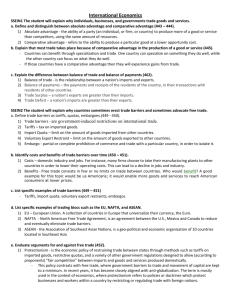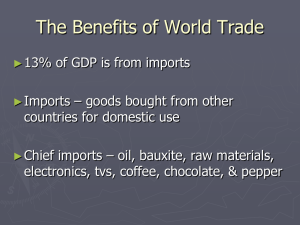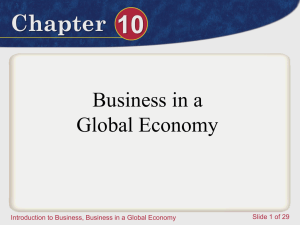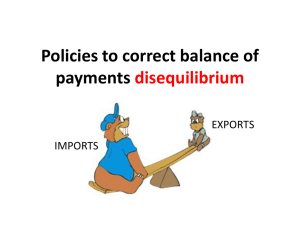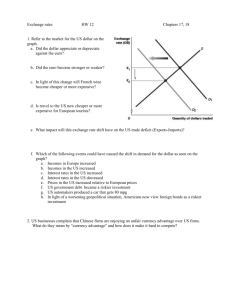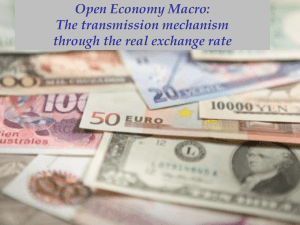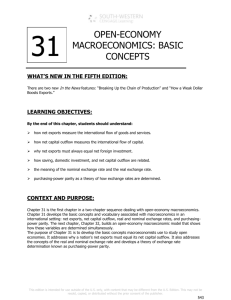Chapter 18
advertisement
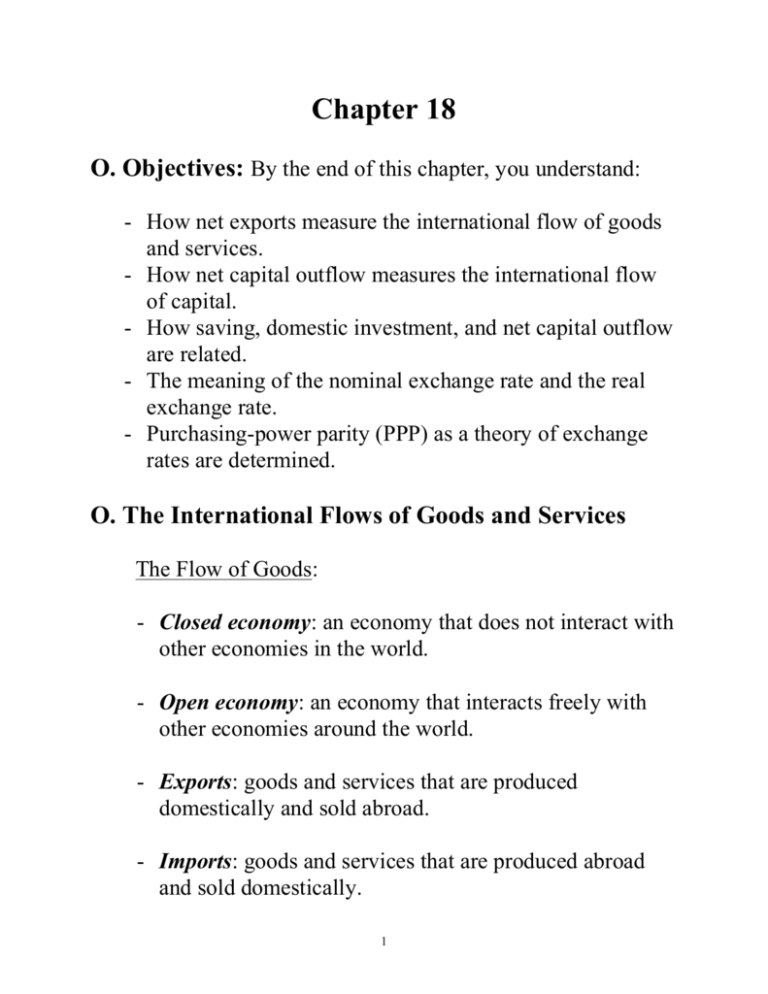
Chapter 18
O. Objectives: By the end of this chapter, you understand:
- How net exports measure the international flow of goods
and services.
- How net capital outflow measures the international flow
of capital.
- How saving, domestic investment, and net capital outflow
are related.
- The meaning of the nominal exchange rate and the real
exchange rate.
- Purchasing-power parity (PPP) as a theory of exchange
rates are determined.
O. The International Flows of Goods and Services
The Flow of Goods:
- Closed economy: an economy that does not interact with
other economies in the world.
- Open economy: an economy that interacts freely with
other economies around the world.
- Exports: goods and services that are produced
domestically and sold abroad.
- Imports: goods and services that are produced abroad
and sold domestically.
1
- Net exports: the value of a nation’s exports minus the
value of its imports, also called the trade balance. (NX =
Exports – Imports)
- Trade balance: the value of a nation’s exports minus the
value of its imports, also called net exports.
- Trade surplus: an excess of exports over imports.
- Trade deficit: an excess of imports over exports.
- Balanced trade: a situation in which exports equal
imports.
- Factors that influence a Country’s Exports, Imports, and
Net Exports.
- The tastes of consumers for domestic and foreign goods.
- The price of goods at home and abroad.
- The exchange rates at which people can use domestic
currency to buy foreign currencies.
- The incomes of consumers at home and abroad.
- The cost of transporting goods from country to country.
- The policies of the gov’t toward international trade.
2
The Flow of Financial Resources:
- Net capital outflow: the purchase of foreign assets by
domestic residents minus the purchase of domestic
assets by foreigners.
- Factors that influence a Country’s Net Capital Outflow
- The real interest rates being paid on foreign assets.
- The real interest rates being paid on domestic assets.
- The perceived economic and political risks of holding
assets abroad.
- The gov’t policies that affect foreign ownership of
domestic assets.
- How foreigners help American Home Buyers? => They
are using funds from their countries’ trade surplus to
purchase US securities. (Capital inflow)
- Exchange Rages
- Three beers example: a Corona (100 pesos), a Beck’s (3
marks), and a Molson (2 Canadian dollars).
- Nominal exchange rate: the rate at which a person can
trade the currency of one country for the currency of
another. ($1 = 10 Pesos or 1 Peso = $0.10)
3
- Appreciation: an increase in the value of a currency as
measured by the amt of foreign currency it can buy.
- Depreciation: a decrease in the value of a currency as
measured by the amt of foreign currency it can buy.
- When a currency appreciates, it is said to strengthen;
when a currency depreciates, it is said to weaken.
- Real exchange rate: the rate at which a person can trade
the goods and services of one country for the goods and
services of another.
- Example 1.
- A bushel of American rice sells for $100 and a bushel
of Japanese rice sell for 16,000 yen. The nominal
exchange rate is 80 yen per dollar. ($1 = ¥80)
- The real exchange rate depends on the nominal
exchange rate and on the prices of goods in the two
countries measured in the local currencies.
Nominal exchange rate x Domestic P
Real Exchange rate = ---------------------------------------------Foreign price
- In our example Real Exchange Rate = {(80 Yen/$1) x
($100/bushel of American rice)} / {16,000 yen/bushel
of Japanese rice}.
4
- Real x-rate = {8,000 yen/bushel of American rice} /
{16,000 yen/bushel of Japanese rice}
- Real x-rate = ½ bushel of Japanese rice PER a
bushel of American rice.
- Example 2.
- Price of Mexican corn = 50 pesos/bushel.
- Price of American corn = $10/bushel.
- Nominal exchange rate: US $1 = 10 pesos.
- How can we find Real X-rate?
2 bushel of Mexican corn/bushel of American corn.
- The real exchange rate is a key determinant of how much
a country exports and imports.
- When studying an economy as a whole, macroeconomists
focus on overall prices instead of the prices of individual
goods and services.
- Price indexes (CPI or GDP deflator) are used to measure
the level of overall prices.
- Assume that P is the price index for the US, P* is a price
index for prices abroad, and e is the nominal exchange
rate btwn the US dollar and foreign currencies.
exP
5
Real Exchange Rate = ------------P*
- The real exchange rate measures the price of a basket of
goods and services available domestically relative to the
price of a basket of goods and services available abroad.
- A depreciation in the US real exchange rate means that
US goods have become cheaper relative to foreign goods.
US exports will rise, imports will fall, and net exports will
decrease.
- Likewise, an appreciation in the US real exchange rate
means that US goods have become more expensive
relative to foreign goods. US exports will fall, imports
will rise, and net exports will decline.
O. A First Theory of Exchange Rate Determination:
Purchasing Power Theory
- Purchasing Power Parity (PPP): a theory of exchange
rates whereby a unit of any given currency should be able
to buy the same quantity of goods in all countries. => the
law of one price
- The law of one price suggests that a good must sell for the
same price in all locations.
- If a good sold for less in one location than another, a
person could make a profit by buying the good in the
6
location where it is cheaper and selling it in the location
where it is more expensive.
- The process taking advantage of differences in prices in
different markets is called arbitrage.
- Note what will happen as people take advantage of the
differences in prices. The price in the location where the
good is cheaper will rise (because the demand is now
higher) and the price in the location where the good was
more expensive will fall (because the supply is greater).
This will continue until the two prices are equal.
- A US dollar should buy the same quantity of goods and
services in the US and Japan; a Japanese yen should buy
the same quantity of goods and services in the US and
Japan.
- PPP suggests that a unit of all currencies must have the
same real value in every country.
- If this was not the case, people would take advantage of
the profit making opportunity and this arbitrage would
then push the real values of the currencies to equality.
Implications of PPP
- PPP means that the nominal exchange rate btwn the
currencies of two countries will depend on the price levels
in those countries.
7
- If a dollar buys the same amt of goods and services in the
US (where prices are measured in dollars) as it does in
Japan (where prices are measured in yen), then the
nominal exchange rate (the number of yen per dollar)
must reflect the prices of goods and services in the two
countries.
- Spse that P is the price of a basket of goods in the US
(measured in dollars), P* is the price of a basket of goods
in Japan (measured in yen), and e is the nominal exchange
rate (the number of yen each dollar can buy).
- In the US the purchasing power of $1 = 1/P.
- In Japan, $1 can be exchanged for e unit of yen, which
in turn have the purchasing power of e/P*.
- PPP implies that the two must be equal: 1/P = e/P*.
- Rearranging, we get: 1 = (e x P)/P*. => Note that the
left-hand side is a constant and the right-hand side is the
real exchange rate. This implies that if the PP of a dollar
is always the same at home and abroad, then the real
exchange rate cannot change.
- We can rearrange again to see that: e = P*/P. => This
implies that the nominal exchange rate is determined by
the ration of the foreign price level to the domestic price
level. This means that nominal exchange rates will
change when price levels change.
8
- Because the nominal exchange rate depends on the price
levels, it must also depend on the money supply and
money demand in each country.
- If the central bank increases the supply of money in a
country and raises the price level, it also causes the
country’s currency to depreciate relative to other
currencies in the world.
- When a central bank prints a large amt of money, that
money loses value both in terms of the goods and
services it can buy and in terms of the amt of other
currencies it can buy.
O. Arbitrage example question
- Molson’s Beer is produced in Canada and sold in many
countries. In the province of Ontario a six-pack of
Molson’s beet sold for $8.75 Canadian. Across the border
in Minnesota, a six-pack of the same beet was for sale for
$5.19 US. At the time, the exchange rate was $0.67 US =
$1.00 Canadian.
(a) How much would it cost in US currency to buy the
beer in Ontario?
(b) How much would it cost in Canadian currency to buy
the beer in Minnesota?
(c) Is there an arbitrage opportunity? If yes, explain why
arbitrage opportunity exists.
9
(d) If there is an arbitrage opportunity, where would you
buy and where would you sell?
(e) How much profit could you expect on a six-pack?
O. Suggested answers for Arbitrage question
(a)
(b)
(c)
(d)
(e)
$8.75 Canadian x 0.67 = $5.86 US.
$5.86 US / 0.67 = $7.75 Canadian.
Yes, since price differential exists.
Buy in Minnesota, sell in Ontario.
The profit per six-pack would be the difference btwn
the price in Ontario, $5.86 US, and the price in
Minnesota, $5.19 US, which equals $0.67 US (or
measured in Canadian currency, a profit of $1.00
Canadian.)
10

